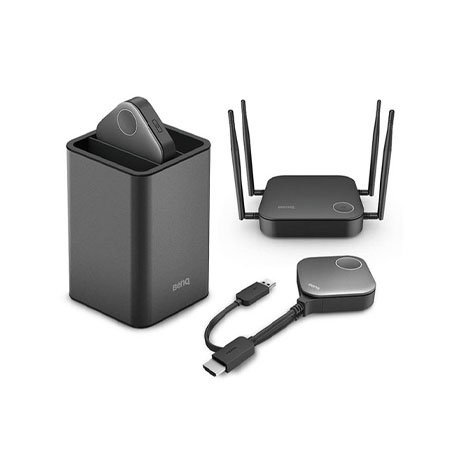Tech That Helps Us Get Back to the Office Safely
- BenQ
- 2020-11-16

What more can we say about 2020 that hasn’t already been told. It’s the year of the challenge, the year of change. And we’ve all had to face these challenges together, which at least has the upside of many people everywhere trying to come up with solutions for shared problems.
Prior to the COVID-19 pandemic, busy offices and fully staffed enterprises of all sizes were of course the norm. Meeting rooms had lots of people in attendance, and brainstorming was done face to face and benefitted from an impromptu nature at SMBs and other dynamic environments. But all that’s changed.
Now we’re dealing with a so-called hybrid work model, with some employees at the office and some at home. Or maybe everyone’s home. And in many cases, those at the office need to maintain social distancing rules and other precautions. All of these can easily get in the way of doing business and getting stuff done.
Fortunately, technology remains our ally. And in 2020, it’s ever more important to help overcome hurdles to productivity and team morale. Let’s take a look at essential technologies that help companies employ new office work approaches, with an emphasis on hybrid work. That is, work that combines local and remote participation, but always promotes safety and health.
Rethinking Office Spaces
COVID-19 and the regulations that governments have enacted in response have had a huge impact on enterprises that rely on face to face communication. Workplaces accustomed to in-person interaction for idea forming and innovation need to rethink how they do things in order to continue in the face of changing circumstances.
Naturally, the “lockdown” state can’t last forever as that’s not tenable. Companies are gradually returning to offices, even if on a part-time, highly controlled basis. This has led to the increasing popularity of the hybrid work model described above. It’s also encouraging companies to rethink their offices to ensure comfortable and safe environments for employees working on-site. All while making sure connectivity, interaction, and collaboration aren’t compromised. Definitely a challenge, but most assuredly doable.
Keep People Informed with Digital Signage
First up is high fidelity digital signage. Why? Because the frontline of combatting any public health issue is readily available information. So instead of goofy and barely legible notes on walls, many businesses are now opting for clear and dynamic digital signage. Screens placed around the office provide employees with helpful advice and guidelines on how to stay safe and healthy. Awareness is important, and with new information coming to the fore all the time, digital screens are much easier to update than printed notices. They’re also far clearer and more appealing, so team members are almost guaranteed to pay attention. That’s a stark contrast from posted notices, which become background noise very quickly and are routinely overlooked.
Wireless Presentation Systems Greatly Reduce the Risk of Infection
One of the most important tools in mitigating COVID-19 appears to be what’s become known as social distancing. That’s keeping six feet or approximately two meters of distance between people. Wireless presentation solutions fit right in with this methodology. They’re designed to get information across, in the most literal sense. That’s across space, without having to touch shared cables and connectors, let alone a communal laptop or something like that.
With solutions like BenQ InstaShow, each of your team members that attends a meeting gets a dongle or adapter. They plug it into InstaShow, then stream content wirelessly via secure, closed-system Wi-Fi from a source device. That can be their personal laptop, tablet, or smartphone. There’s no need for people to get physically close nor share presentation tools. The risk of infection is thus immensely reduced compared to traditional meeting setups. Employees can even leave dongles at the meeting room if desired, as there’s no need to carry them around outside the meeting space.
Importantly, the old meeting room shuffle of employees changing seats and getting up to plug and unplug cables from a shared projector that requires a lot of fiddling is gone. InstaShow works 99% wirelessly, with only one physical button needing to be pressed.
Accommodating the Growth of Video Conferences
The so-called Zoom Boom will surely go down in history as one of the hallmarks of 2020. Video call apps like Zoom and Microsoft Team, but especially the former, have grown in popularity on an exponential scale due to the emergence of remote and hybrid work. The BenQ InstaShow WDC20 in particular features many capabilities tailored to enable video conferencing. Primary among those is seamless and easy-to-do split screen presentation. You can have an entire team on screen, or multiple employees and presentation materials alongside each other. The flexibility on offer makes video conferences highly productive, compensating for the loss of face to face interaction.
Adapt and Thrive
The bottom line here is that the tools to adjust how we work exist, and aren’t even all that expensive, complicated, or difficult to implement. There’s no need to completely reinvent offices, just tweak them. Nor do you need to invest in big ticket purchases that’ll further stress company finances in these trying times. Technology like digital signage and wireless presentation systems costs about the same as monitors, and buying those is totally normal and obligatory at every business and organization. The new routine is investing a little in technology that promotes health, builds confidence, and ensures continuous productivity.
Stay safe, stay innovative!
Recommended Articles
-
Trends & Knowledge
Office Meetings in Social Distancing Era?
2020.05.31 -
Trends & Knowledge
How Wireless Presentation and Projectors Make Social Distancing Easier for Safer Offices
2020.11.30 -
Trends & Knowledge
Employee Collaboration in COVID-19?
COVID-19 pandemic brought many challenges to the business world. Here is how wireless presentation helps you to help safe and effective business meetings from six feet away.
2020.07.31
